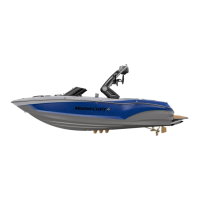2016 OWNERS MANUAL / 041
FLOAT PLAN
A “float plan” is a written record indicating the planned destination
and approximate length of time for the outing. Sample forms are
available at the Coast Guard’s website. One should be completed
and left with a relative or friend prior to each trip. In case of an emer-
gency or failure to return within a reasonable period of time, perti-
nent information will be available to assist local marine police or the
Coast Guard in determining whether a search should be performed.
Be sure to notify the float plan holder upon return.
STAYING AFLOAT
It is commonly believed that someone dressed in heavy clothing or
waders will experience considerably more difficulty staying afloat if
they fall overboard. This is not true. Air trapped in clothing provides
flotation and bending the knees will trap air in waders.
To stay afloat:
• Remain calm. Do not thrash about or try to remove clothing or
footwear. This leads to exhaustion and increases the loss of air
that may keep you afloat.
NAUTICAL CHARTS
Nautical charts are especially important to boaters planning trips,
particularly on open waters. These charts show the nature and
shape of the coast, depths of water, general configuration and
character of the bottom of the body of water. Other markings on the
nautical charts include prominent landmarks, port facilities, aids to
navigation, and marine hazards. Changes brought about by people
and nature require that nautical charts be constantly maintained
and updated to aid safe navigation.
National Ocean Service (NOS) charts may be purchased either
directly by mail from the NOS Distribution Branch or through an
authorized agent. There are more than 1,700 nautical chart agents
who sell them.
FAA/NATIONAL AERONAUTICAL CHARTING OFFICE
Distribution Division, AVN-530
6303 Ivy Lane, Suite 400
Greenbelt, MD 20770
Telephone: (301) 436-8301
Email: 9-AMC-chartsales@faa.gov
http://naco.faa.gov/

